Aishwarya Agrawal
CulturalFrames: Assessing Cultural Expectation Alignment in Text-to-Image Models and Evaluation Metrics
Jun 10, 2025Abstract:The increasing ubiquity of text-to-image (T2I) models as tools for visual content generation raises concerns about their ability to accurately represent diverse cultural contexts. In this work, we present the first study to systematically quantify the alignment of T2I models and evaluation metrics with respect to both explicit as well as implicit cultural expectations. To this end, we introduce CulturalFrames, a novel benchmark designed for rigorous human evaluation of cultural representation in visual generations. Spanning 10 countries and 5 socio-cultural domains, CulturalFrames comprises 983 prompts, 3637 corresponding images generated by 4 state-of-the-art T2I models, and over 10k detailed human annotations. We find that T2I models not only fail to meet the more challenging implicit expectations but also the less challenging explicit expectations. Across models and countries, cultural expectations are missed an average of 44% of the time. Among these failures, explicit expectations are missed at a surprisingly high average rate of 68%, while implicit expectation failures are also significant, averaging 49%. Furthermore, we demonstrate that existing T2I evaluation metrics correlate poorly with human judgments of cultural alignment, irrespective of their internal reasoning. Collectively, our findings expose critical gaps, providing actionable directions for developing more culturally informed T2I models and evaluation methodologies.
REARANK: Reasoning Re-ranking Agent via Reinforcement Learning
May 26, 2025Abstract:We present REARANK, a large language model (LLM)-based listwise reasoning reranking agent. REARANK explicitly reasons before reranking, significantly improving both performance and interpretability. Leveraging reinforcement learning and data augmentation, REARANK achieves substantial improvements over baseline models across popular information retrieval benchmarks, notably requiring only 179 annotated samples. Built on top of Qwen2.5-7B, our REARANK-7B demonstrates performance comparable to GPT-4 on both in-domain and out-of-domain benchmarks and even surpasses GPT-4 on reasoning-intensive BRIGHT benchmarks. These results underscore the effectiveness of our approach and highlight how reinforcement learning can enhance LLM reasoning capabilities in reranking.
CTRL-O: Language-Controllable Object-Centric Visual Representation Learning
Mar 27, 2025Abstract:Object-centric representation learning aims to decompose visual scenes into fixed-size vectors called "slots" or "object files", where each slot captures a distinct object. Current state-of-the-art object-centric models have shown remarkable success in object discovery in diverse domains, including complex real-world scenes. However, these models suffer from a key limitation: they lack controllability. Specifically, current object-centric models learn representations based on their preconceived understanding of objects, without allowing user input to guide which objects are represented. Introducing controllability into object-centric models could unlock a range of useful capabilities, such as the ability to extract instance-specific representations from a scene. In this work, we propose a novel approach for user-directed control over slot representations by conditioning slots on language descriptions. The proposed ConTRoLlable Object-centric representation learning approach, which we term CTRL-O, achieves targeted object-language binding in complex real-world scenes without requiring mask supervision. Next, we apply these controllable slot representations on two downstream vision language tasks: text-to-image generation and visual question answering. The proposed approach enables instance-specific text-to-image generation and also achieves strong performance on visual question answering.
UI-Vision: A Desktop-centric GUI Benchmark for Visual Perception and Interaction
Mar 19, 2025Abstract:Autonomous agents that navigate Graphical User Interfaces (GUIs) to automate tasks like document editing and file management can greatly enhance computer workflows. While existing research focuses on online settings, desktop environments, critical for many professional and everyday tasks, remain underexplored due to data collection challenges and licensing issues. We introduce UI-Vision, the first comprehensive, license-permissive benchmark for offline, fine-grained evaluation of computer use agents in real-world desktop environments. Unlike online benchmarks, UI-Vision provides: (i) dense, high-quality annotations of human demonstrations, including bounding boxes, UI labels, and action trajectories (clicks, drags, and keyboard inputs) across 83 software applications, and (ii) three fine-to-coarse grained tasks-Element Grounding, Layout Grounding, and Action Prediction-with well-defined metrics to rigorously evaluate agents' performance in desktop environments. Our evaluation reveals critical limitations in state-of-the-art models like UI-TARS-72B, including issues with understanding professional software, spatial reasoning, and complex actions like drag-and-drop. These findings highlight the challenges in developing fully autonomous computer use agents. By releasing UI-Vision as open-source, we aim to advance the development of more capable agents for real-world desktop tasks.
Assessing and Learning Alignment of Unimodal Vision and Language Models
Dec 05, 2024



Abstract:How well are unimodal vision and language models aligned? Although prior work have approached answering this question, their assessment methods do not directly translate to how these models are used in practical vision-language tasks. In this paper, we propose a direct assessment method, inspired by linear probing, to assess vision-language alignment. We identify that the degree of alignment of the SSL vision models depends on their SSL training objective, and we find that the clustering quality of SSL representations has a stronger impact on alignment performance than their linear separability. Next, we introduce Swift Alignment of Image and Language (SAIL), a efficient transfer learning framework that aligns pretrained unimodal vision and language models for downstream vision-language tasks. Since SAIL leverages the strengths of pretrained unimodal models, it requires significantly fewer (6%) paired image-text data for the multimodal alignment compared to models like CLIP which are trained from scratch. SAIL training only requires a single A100 GPU, 5 hours of training and can accommodate a batch size up to 32,768. SAIL achieves 73.4% zero-shot accuracy on ImageNet (vs. CLIP's 72.7%) and excels in zero-shot retrieval, complex reasoning, and semantic segmentation. Additionally, SAIL improves the language-compatibility of vision encoders that in turn enhance the performance of multimodal large language models. The entire codebase and model weights are open-source: https://lezhang7.github.io/sail.github.io/
VisMin: Visual Minimal-Change Understanding
Jul 23, 2024


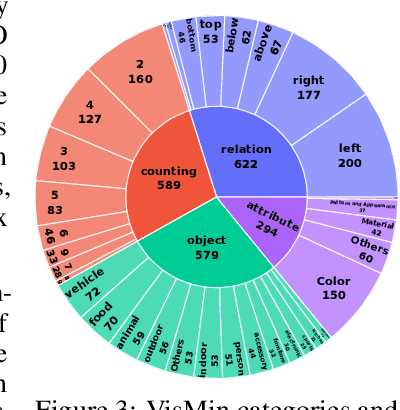
Abstract:Fine-grained understanding of objects, attributes, and relationships between objects is crucial for visual-language models (VLMs). Existing benchmarks primarily focus on evaluating VLMs' capability to distinguish between two very similar \textit{captions} given an image. In this paper, we introduce a new, challenging benchmark termed \textbf{Vis}ual \textbf{Min}imal-Change Understanding (VisMin), which requires models to predict the correct image-caption match given two images and two captions. The image pair and caption pair contain minimal changes, i.e., only one aspect changes at a time from among the following: \textit{object}, \textit{attribute}, \textit{count}, and \textit{spatial relation}. These changes test the models' understanding of objects, attributes (such as color, material, shape), counts, and spatial relationships between objects. We built an automatic framework using large language models and diffusion models, followed by a rigorous 4-step verification process by human annotators. Empirical experiments reveal that current VLMs exhibit notable deficiencies in understanding spatial relationships and counting abilities. We also generate a large-scale training dataset to finetune CLIP and Idefics2, showing significant improvements in fine-grained understanding across benchmarks and in CLIP's general image-text alignment. We release all resources, including the benchmark, training data, and finetuned model checkpoints, at \url{https://vismin.net/}.
Benchmarking Vision Language Models for Cultural Understanding
Jul 15, 2024Abstract:Foundation models and vision-language pre-training have notably advanced Vision Language Models (VLMs), enabling multimodal processing of visual and linguistic data. However, their performance has been typically assessed on general scene understanding - recognizing objects, attributes, and actions - rather than cultural comprehension. This study introduces CulturalVQA, a visual question-answering benchmark aimed at assessing VLM's geo-diverse cultural understanding. We curate a collection of 2,378 image-question pairs with 1-5 answers per question representing cultures from 11 countries across 5 continents. The questions probe understanding of various facets of culture such as clothing, food, drinks, rituals, and traditions. Benchmarking VLMs on CulturalVQA, including GPT-4V and Gemini, reveals disparity in their level of cultural understanding across regions, with strong cultural understanding capabilities for North America while significantly lower performance for Africa. We observe disparity in their performance across cultural facets too, with clothing, rituals, and traditions seeing higher performances than food and drink. These disparities help us identify areas where VLMs lack cultural understanding and demonstrate the potential of CulturalVQA as a comprehensive evaluation set for gauging VLM progress in understanding diverse cultures.
Decompose and Compare Consistency: Measuring VLMs' Answer Reliability via Task-Decomposition Consistency Comparison
Jul 10, 2024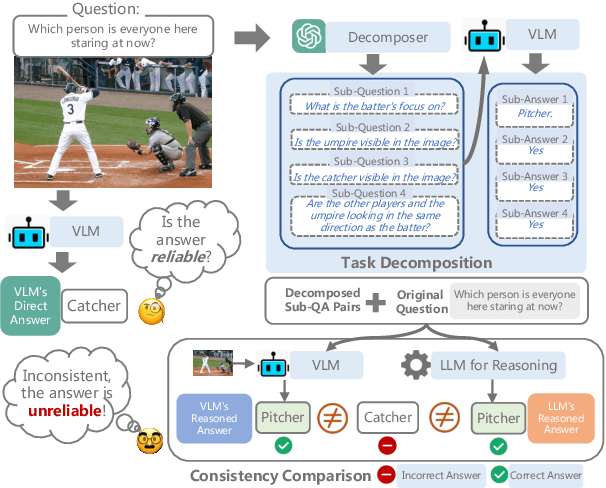
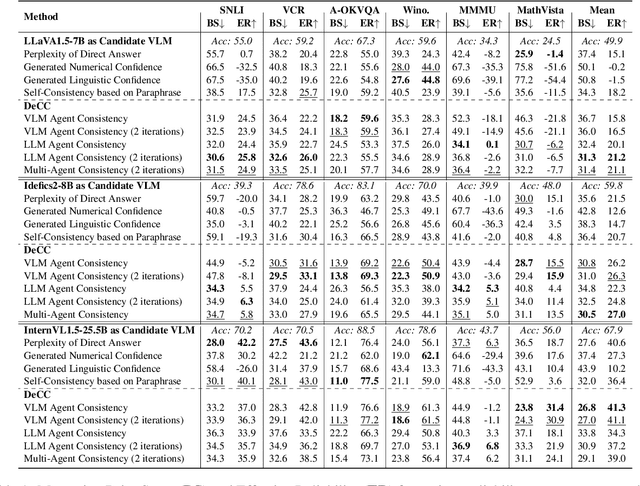
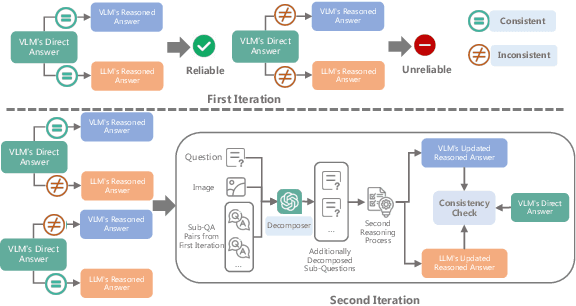
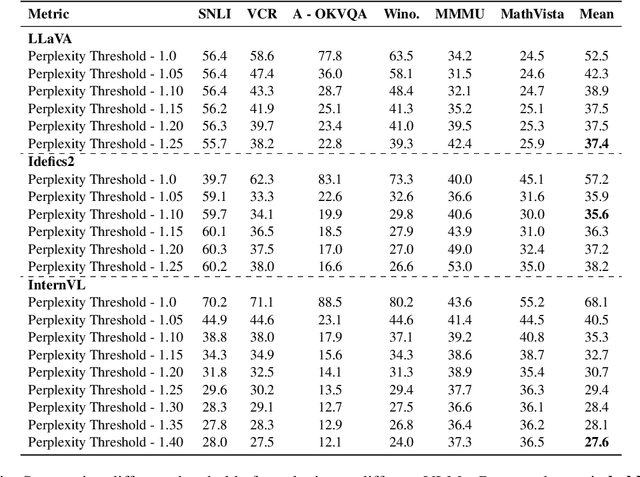
Abstract:Despite tremendous advancements, current state-of-the-art Vision-Language Models (VLMs) are still far from perfect. They tend to hallucinate and may generate biased responses. In such circumstances, having a way to assess the reliability of a given response generated by a VLM is quite useful. Existing methods, such as estimating uncertainty using answer likelihoods or prompt-based confidence generation, often suffer from overconfidence. Other methods use self-consistency comparison but are affected by confirmation biases. To alleviate these, we propose \textbf{De}compose and \textbf{C}ompare \textbf{C}onsistency (\texttt{DeCC}) for reliability measurement. By comparing the consistency between the direct answer generated using the VLM's internal reasoning process, and the indirect answers obtained by decomposing the question into sub-questions and reasoning over the sub-answers produced by the VLM, \texttt{DeCC} measures the reliability of VLM's direct answer. Experiments across six vision-language tasks with three VLMs show \texttt{DeCC}'s reliability estimation achieves better correlation with task accuracy compared to the existing methods.
An Introduction to Vision-Language Modeling
May 27, 2024


Abstract:Following the recent popularity of Large Language Models (LLMs), several attempts have been made to extend them to the visual domain. From having a visual assistant that could guide us through unfamiliar environments to generative models that produce images using only a high-level text description, the vision-language model (VLM) applications will significantly impact our relationship with technology. However, there are many challenges that need to be addressed to improve the reliability of those models. While language is discrete, vision evolves in a much higher dimensional space in which concepts cannot always be easily discretized. To better understand the mechanics behind mapping vision to language, we present this introduction to VLMs which we hope will help anyone who would like to enter the field. First, we introduce what VLMs are, how they work, and how to train them. Then, we present and discuss approaches to evaluate VLMs. Although this work primarily focuses on mapping images to language, we also discuss extending VLMs to videos.
Improving Text-to-Image Consistency via Automatic Prompt Optimization
Mar 26, 2024



Abstract:Impressive advances in text-to-image (T2I) generative models have yielded a plethora of high performing models which are able to generate aesthetically appealing, photorealistic images. Despite the progress, these models still struggle to produce images that are consistent with the input prompt, oftentimes failing to capture object quantities, relations and attributes properly. Existing solutions to improve prompt-image consistency suffer from the following challenges: (1) they oftentimes require model fine-tuning, (2) they only focus on nearby prompt samples, and (3) they are affected by unfavorable trade-offs among image quality, representation diversity, and prompt-image consistency. In this paper, we address these challenges and introduce a T2I optimization-by-prompting framework, OPT2I, which leverages a large language model (LLM) to improve prompt-image consistency in T2I models. Our framework starts from a user prompt and iteratively generates revised prompts with the goal of maximizing a consistency score. Our extensive validation on two datasets, MSCOCO and PartiPrompts, shows that OPT2I can boost the initial consistency score by up to 24.9% in terms of DSG score while preserving the FID and increasing the recall between generated and real data. Our work paves the way toward building more reliable and robust T2I systems by harnessing the power of LLMs.
 Add to Chrome
Add to Chrome Add to Firefox
Add to Firefox Add to Edge
Add to Edge